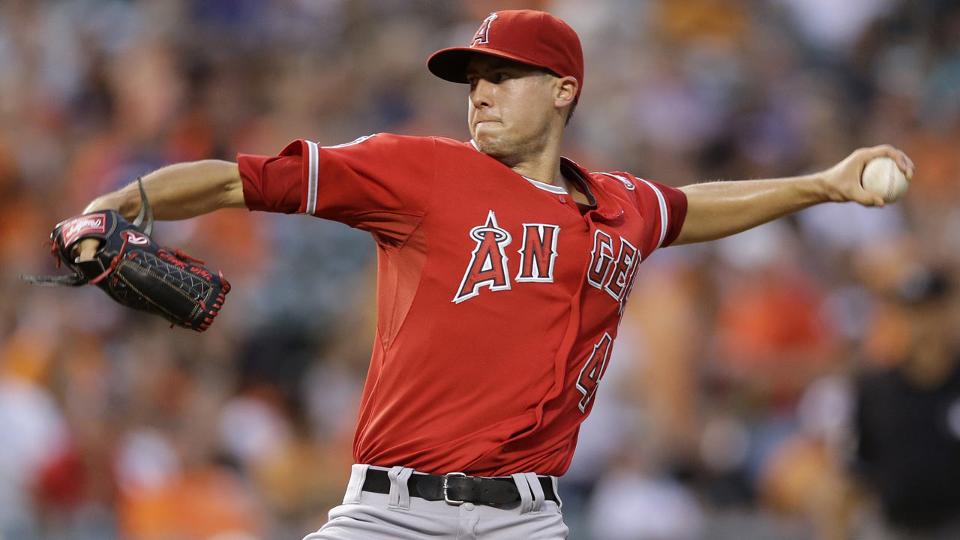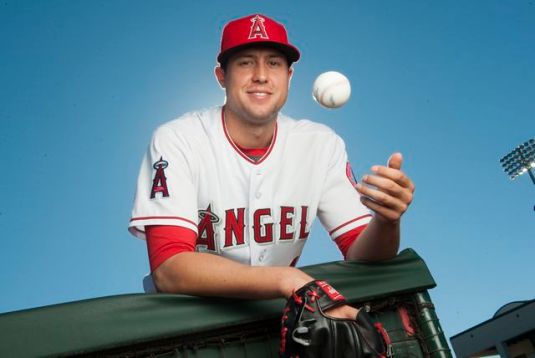By Steve Zavala, AngelsWin.com Columnist
When the season began, the Angels starting rotation was much of an unknown filled with questions and concerns. Andrew Heaney, Garrett Richards and Nick Tropeano were all coming off three straight injury-riddled seasons. Prized prospect Shohei Ohtani was coming over from Japan with high expectations. Alex Meyer and J.C Ramirez hurt the Angels depth early on with season-ending injuries. The team had several promising pitching prospects in the minors but did not have a set timeline as to when they would be ready for a call-up to the majors.
And most importantly, the team has been waiting for a pitcher to step up and finally have an All-Star caliber season to lead the rotation.
In the midst of it all, the starting rotation has overachieved expectations as they have been led by the emergence of a new ace, Tyler Skaggs.
The 26-year-old left-hander is currently having a breakout, near All-Star type season and by far the best year of his career. Skaggs is currently on pace to set career highs in ERA, innings pitched, and strikeouts while also sporting an impressive 2.3 WAR– which is higher than his first five seasons combined (0.8). His eight quality starts this season has already tied a career from that of his 2014 season but he has done it in three fewer starts so far.
Skaggs is most notably impressing with his 2.69 ERA, which leads all Angels starters and currently ranks 9th among qualified AL starters. June has arguably been his most impressive month. Among qualified AL starting pitchers with at least 20 innings pitched, Skaggs leads all starters with an outstanding 0.67 ERA in June.
Now while ERA does not paint the entire picture as to why a pitcher is having major success or is struggling, Skaggs has in large part been able to successfully minimize damage when in trouble and finish with a quality start. While Skaggs has allowed a mediocre .246 opponents batting average (BAA), he has been fair in allowing a .226 average with runners in scoring position (RISP) and an overall .199 average with men on base. This can be credited also to his success against lefties as he has held them to a .178 average.
Seeing a pitcher be able to take command of a situation when in trouble such as when the opposing team has RISP is like a breath of fresh air for Angels fans. The fan base has had to endure seasons with starting pitchers who struggled mightily to escape RISP situations such as with Joe Blanton, Ricky Nolasco and C.J Wilson.
Skaggs has delivered the most when needed by the Angels, whether it has been to end a losing streak or to clinch a pivotal series win. Over the course of the first half of the season, Skaggs has earned the trust of Angels manager Mike Scioscia to go deeper into games and fight his way through difficult innings. From his seven scoreless innings performance against the Astros in April to his latest start which saw him go seven scoreless against the Royals, Skaggs has been the workhorse pitcher that the Angeles desperately needed this season.
Now when digging deep to examine his pitch arsenal, he uses four pitches: four seam fastball, curveball, changeup and sinker. None of his four main pitches are a nasty, lights out pitch that can fool batters time after time even when the opponent has an idea of which pitch to expect. Instead, Skaggs has been effective with his command and aggressive when ahead of the count.
Starting with his four seam fastball, the pitch has undergone gradual improvement over the years. His fastball is not an Aroldis Chapman type that would light up the radar gun or a Max Scherzer type with excellent command in the high 90s. Instead, it ranges in the low 90s with an average speed of 92 mph. It is not outstanding like Scherzer’s or atrocious like Jered Weaver late in his career but at the end of the day, it is effective.
Skaggs utilizes his fastball 41% of the time, most of any pitch. Last season in 16 starts, opponents were hitting .290 off of his fastball but in comparison to this season, opponents are hitting .235. Also last season, he recorded a .303 on batting average on balls in play (BABIP) while having a .295 BABIP this season. As alluded to before, it is not great nor atrocious but it gets the job done.
One trait about his fastball is that he is beginning to throw it high out of the zone. This is preferable for Skaggs especially when he is ahead in the count and looking to fool a batter. As seen in this pitch, Skaggs goes for the high 92 mph fastball to strike out Jake Marisnick.
Onto his curveball, the pitch has become one that Skaggs is relying on more but has not had consistent results with it. Last season, he threw the curve 432 times in 113 plate appearances while recording a .208 BAA. This season, he has thrown the curve 455 times in 116 plate appearances but opponents are hitting .264 against it. The .264 BAA is not something to worry about but rather a pitch that could need vast improvement, especially down in the zone.
When used effectively and with control in the zone, it could be his biggest strength pitch. A 75 mph curve, which he has recorded 40% of his strikeouts with, can be his nasty pitch if developed well. Skaggs’ curveball has a good, late drop as seen in his last start against the Royals with his 6th inning strikeout of Salvador Perez.
Skaggs’ 84 mph changeup, his 3rd main pitch, has also undergone a positive transformation with superb direction and movement. Opponents are hitting .180 against the pitch. He has also doubled the SwSTR%, swings and misses percentage, up to 14.8%. To an extent, his changeup success can be credited to playing behind an outstanding Angels defense as the pitch has a .207 BABIP.
With his 4th and final pitch, Skaggs’ 91 mph sinker is far from what he had hoped it would deliver this season as opponents are hitting .300 against it. He has recorded just three strikeouts from it with a 40.2 Swing%. If he can get the sinker to suddenly become a reliable one that can be used as a strikeout pitch, it would only give him more flexibility and options to finish off a batter.
Even with his success this season, there is still room for improvement. His fastball and changeup are two pitches that he has had promising success with when located in the zone but he must still work to perfect his sinker and curveball. At this stage in his career, Skaggs is a work in progress but there is promise in his pitch arsenal. The Angels are finally starting to see Skaggs’ potential as a starter but at this rate, the best is yet to come.
Skaggs is one of the bright spots on an unbalanced Angels team that is currently on a rough patch over the past month. If the team begins to pick it up with the offense producing up to their capabilities and bullpen suddenly becoming a reliable force, then Skaggs could very well be leading the pitching staff into a tightly contested playoff race. Among others, the Angels hope that Skaggs performances over the past three months are not a one-hit wonder but rather the beginning of a new chapter as the Angels prominent ace.
Do you have a take or want to leave a comment on this article? Click on our logo below to enter the discussion on this topic.
Add The Sports Daily to your Google News Feed!

